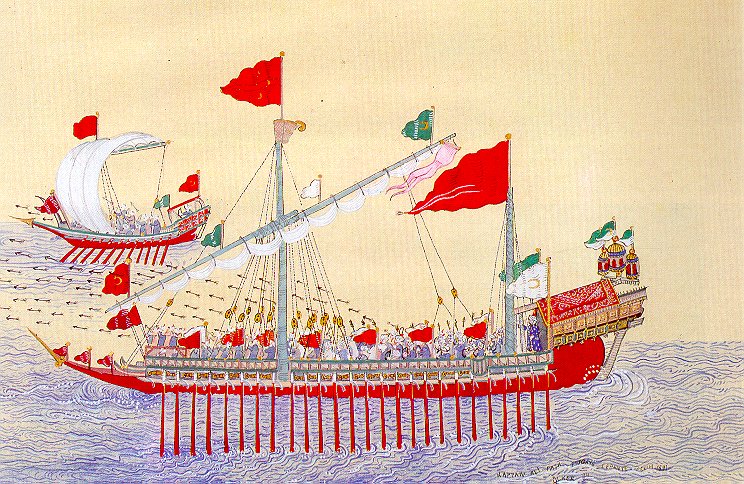
A typical Ottoman galley.
A Portuguese map made in 1519 depicting Indian Ocean
areas.
Finally, the Portuguese caught the evil Turkish pirate Mir
Ali Bec with 4 Galleys and 1 Fusta in Mombasa, on the African East Coast. The
Turks have built a fort with heavy artillery south of the harbour to protect
the ships from the east and prevent the Portuguese ships to enter the strait.
They have two galleys near it and the Portuguese captain, Tomé de Sousa
Coutinho, sensing that the time was now, with the sailors and soldiers aboard
electrified with the sight of the Turkish ships decided to attack. He has 8
Fustas under Mateus Mendes de Vasconcelos; followed by 8 Galliots and a reserve
of 4 galleys under his direct command. But by this time, an army of Zimbas (a
“cannibal” African tribal army) is trying to cross the strait from
the mainland to attack the island (Mombasa).
In the morning of March 5th Mir Ali Bec sent 2 galleys to
prevent the Zimbas from crossing because it was possible to do so during low
tide.
As the Portuguese squadron arrived the captain ordered all hands-on
deck with colors flying with fifes playing and drums beating to announce their
arrival to the Turks. Without paying any interest to the Turkish artillery the
Portuguese fleet headed to the port and discharged an artillery barrage against
the two Turkish Galleys without any effect. But the Portuguese capitânia
(flagship) was able to send some well-aimed volleys at the Turkish fort and
killed (maybe with some luck) the Maomethan artillery officer.
Most of the Turks lost moral and abandoned the fort heading
to the main town. Seeing this, a young Portuguese officer with half a dozen soldiers
got on a small boat from the Galley capitânia and landed near the fort,
attacking it with “arme blanche”! After killing the rest of the
garrison they returned to the Portuguese squadron with the Turkish flags.
The Portuguese ships sailed past the fort into the harbour
determined to engage the remaining Turkish vessels. The Muslims fired two
rounds before Mateus Mendes de Vasconcelos and his soldiers and mariners
boarded the Turkish fleet. The meleé was so fierce, with handguns firing and
powder kegs thrown from the Portuguese ships that the Turks jumped overboard
and swam ashore. Such was the excitement that some of the Portuguese jumped
after the Turks in pursuit and the captain had to send a couple of officer ashore
to rally them. The captain general, Tomé de Sousa sent 100 men to carry the
guns from the fort while Mateus de Vasconcelos with 2 Galleys, 7 Galliots and 6
Fustas sailed up the strait to attack the 2 remaining Turkish Galleys guarding
the passage from the main continent against the Zimbas, as Tomé de Sousa
remained in front of the town with the remaining 2 Galleys and Fustas. The
combat with the two remaining Turkish Galleys was fiercer than the previous
because they were the best armed and equipped. The Portuguese once again
grappled the Turkish vessels and an intense hand-to-hand fight, arquebus
firing, “Panelas de Pólvora” (powder mines) throwing ensued with the
Portuguese getting the upper hand because of their numbers. The Turks lost many
men with 70 being taken prisoners. The Portuguese lost a few wounded and two
killed. The rest of the day was spent dividing the spoils of the Turkish cargo.
The King of Mombasa was given 24h, by Tomé de Sousa, to deliver all Turks in
town. Next day, March 6th, was spent loitering and searching the Turkish ships.
On the 7th, since the King of Mombasa hadn’t sent any information about the
Portuguese terms, the commander of the fleet, Tomé de Sousa, disembarked 500
soldiers and headed to the town but found no resistance. They sacked and burnt
the buildings, along with a great ship and several small boats, before
returning to the fleet. During the raid a Zimba emissary reached the Portuguese
and requested permission to enter the island. The Portuguese captain gave his approval
for the next day, March 8th. As the Portuguese captain had foreseen as soon as
the Zimbas entered the island the fugitives, Africans, Arabs and Turks, began
to run from their hiding and tried to reach the Portuguese ships. Among them
was Mir Ali Bec with 30 soldiers and officers along with around 200 Arabs and
many more natives. Scores drowned trying to reach the ships. On the 15th of
March arrived two Galleons of the Indian Fleet that had been “lost”
during the crossing from India in the Arabian Seas to escort the fleet while
Tomé de Sousa Coutinho sailed all along the Indian Ocean and paid visit to the
kings of Lamu, Pate and Mandra for their support to the Turks. On the 16th of
May 1589 the fleet arrived in Goa with flying colours and Mir Ali Bec was sent
to Portugal where he converted to the Catholic faith.
The Portuguese have around 500 experienced soldiers divided
mainly by the Galleys and Galliots. They are fierce but difficult to control.
The Turks have around 250 soldiers divided by the Galleys and in the fort. They
have better soldiers in the two Galleys blocking the Zimbas.
Portuguese Squadron
Tomé de Sousa Coutinho
Mateus Mendes de Vasconcelos
8 Fustas
8 Galliots
4 Galleys (reserve)
Turkish Squadron
Mir Ali Bec
4x Galleys
1x Fusta